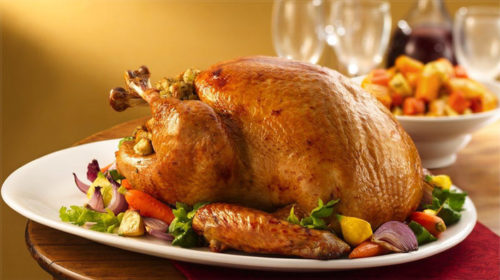Let’s talk turkey.
Often the centrepiece of a big holiday meal, it’s kind of crucial. It’s also easy to overcook and/or underflavour. So what’s a cook to do? Brine the bird! Brining is your ticket to a moist, delicious turkey. Read on to learn the difference between wet and dry brining, and the pros and cons of each.
Option 1: Wet Brine
Advantages:
- relatively easy
- proven effective
- relatively quick
- communicates to nosy/snobby relatives that you’re working hard to make the best meal possible
Disadvantages:
- requires a lot of space
- cooling your large pot of brine outside in the city of trash pandas is risky business
Basically, wet brining (aka what almost everybody means when they talking about brining a bird) is the process of submerging the turkey in salted water for a few days. The bird stays moist and juicy during cooking, and is infused with the flavours of salt and whatever else you’ve added to the brine… and you don’t end up with a dry, bland turkey situation. In fact, for that extra turkey flavour, some people like to brine their turkey in turkey stock – so if you’re so inclined, you can pick up some fresh organic made in-house turkey stock and take things to the next level!
The trickiest part of a wet brine is finding a container big enough to contain the bird and the liquid, and then making sure you have enough room in your fridge for it. If you’ve got that sorted, you’re good to go!
- Place a cleaned (cleaned, dried, giblets removed) turkey into a pot big enough to hold it and 4 L of water.
- In another pot, warm 1 L of water and stir in 1 cup of kosher salt (or ¾ cup of table salt), until totally dissolved.
- When the water is cool enough to touch (you don’t want to scald the bird), pour it into the pot with the turkey. Add another 3 L of water, and any aromatics you want to include. We like to throw in a bunch of sage, black peppercorns, and a few bay leaves.
- Cover the pot (if the turkey is floating, weigh it down with a plate or something so it’s totally submerged), and leave it in the fridge for at least two and up to 24 hours.
- Remove the turkey from the brine, rinse it, and pat it dry.
Option 2: Dry Brine
Advantages:
- a novel technique (impress your foodie friends)
- takes up less space
- doesn’t require any follow-up (is immediately ready to cook)
Disadvantages:
- gives critical family something to pick on
- involves leaving an uncovered raw turkey in your fridge for days – so if you have little kids who are old enough to open the fridge and grab things but not yet old enough to respect boundaries, you might have a problem
A dry brine is basically the same thing as a wet brine, only without the water! All you do is rub the salt and spices directly into the turkey, and then leave it in the fridge overnight or for up to three days.
- Clean and dry your bird. Remove the giblets.
- Mix together 3 tbsp salt, ¾ tbsp ground black pepper, and about another 1½ tsp dried spices (we like to go hard on sage and thyme, but you do you).
- Sprinkle 2 tsp of the salt mix into the cavity of the bird.
- If you’re feeling fancy, carefully lift the skin from the breast of the bird, and rub another 4 tsp of the salt mixture into the breasts (under the skin).
- Sprinkle the remaining salt mixture onto the skin of the bird, focusing on the breast and the legs.
- Place the turkey breast-side up on a baking sheet or roasting pan and leave it uncovered in the fridge for 12-72 hours.
After Brining:
Whichever technique you use, once you’re done with the brine you can cook your turkey as you usually would. Brining can often shorten cooking time (the salt helps to break down the muscle proteins, so the bird is less tough before it even goes into the oven), so we’d recommend checking for doneness (with a meat thermometer) about an hour earlier than you’d think.
In Conclusion:
These are both really good techniques, and I personally can’t wait until I have the opportunity to cook two turkeys simultaneously, so I can dry-brine one and wet-brine the other and decide for myself which is better.
Honestly though, one of the best things you can do is make sure you’re starting with a good, healthy animal. All of the turkeys we sell at The Sweet Potato are locally and humanely raised at Yorkshire Valley Farms, where they are pastured and raised without antibiotics or hormones (and eat GMO-Free feed). Combine a great organic bird with some good brining, and then serve it with some wild rice and quinoa stuffing, roasted brussels sprouts, and sweet potato pie and you’ve got yourself a recipe for success any way you brine it!

